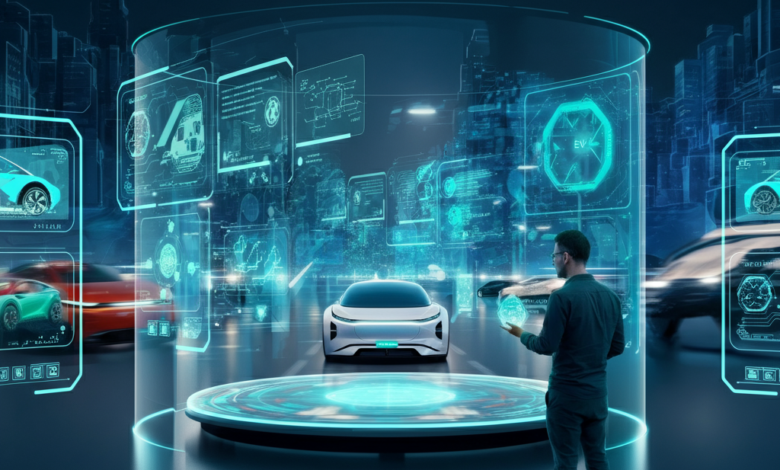EVS Full Form Explained: Unpacking Its Role in the Electric Vehicle Industry

The electric vehicle (EV) market is accelerating into a new era of sustainable transportation. With growing technological advancements, infrastructure development, and global emphasis on reducing carbon emissions, EVs are no longer futuristic— they are here and booming. Amid this rapid progression, you might stumble upon the acronym “EVS” and wonder, what does it stand for, and why is it significant in the world of electric vehicles?
Whether you’re an electric vehicle enthusiast, an advocate for sustainable technology, or an automotive industry professional, understanding EVS and its pivotal role in EVs is vital. This post will cover the full form of EVS, its evolution, and its importance in revolutionizing the auto industry.
What is EVS?
EVS stands for Electric Vehicle System, a fundamental concept that defines the interconnected network of components and technologies that power electric vehicles. Simply put, the EVS integrates all the essential elements— from battery packs and motors to controllers and power electronics— that bring an electric vehicle to life.
While EVS may seem like just another technical term, it encompasses the very backbone of EV technology. Without advanced Electric Vehicle Systems, the high performance, efficiency, and sustainability of EVs would remain a distant dream.
Evolution of EVS
To understand the importance of EVS in today’s automotive industry, it’s essential to look back at its roots.
The Early Days of Electric Vehicles
The history of electric vehicles dates back to the 19th century. Early electric carts and carriages featured rudimentary components— an electric motor, basic batteries, and primitive controls. While revolutionary at the time, these systems lacked the sophistication, efficiency, and reliability of today’s EVS.
Key Milestones in EVS Development
The Electric Vehicle System as we know it began to take shape in the late 20th and early 21st centuries, influenced by advances in battery technology and power electronics. Key developments include:
- Lithium-Ion Batteries (1991): Sony’s development of these batteries revolutionized energy storage with lightweight, powerful, and rechargeable cells.
- Regenerative Braking Systems (1997): Introduced widely in hybrid cars like the Toyota Prius, regen braking became a hallmark of efficient EV systems.
- Enhanced Powertrain Control (Early 2000s): Sophisticated software and sensors enabled better energy optimization across battery, motor, and power electronics.
These milestones set the stage for the complex, efficient EVS we see in modern electric vehicles.
Significance of EVS in Electric Vehicles
Electric Vehicle Systems are not just technical jargon; they are the keystone of every EV’s performance, sustainability, and user experience.
Improving Vehicle Performance
The advanced integration of EVS ensures enhanced performance. Components like electric motors and power inverters work in harmony to deliver instant torque, improved acceleration, and smooth drivability— far superior to traditional internal combustion engine (ICE) systems.
Increasing Energy Efficiency
Energy efficiency is a hallmark of Electric Vehicle Systems. Compared to ICE vehicles, which waste a significant amount of energy as heat, EVS optimizes energy usage. For instance:
- Precision Energy Management reduces wastage and extends battery life.
- Regenerative Braking Systems capture energy lost during braking, feeding it back into the battery.
Environmental Benefits
With zero tailpipe emissions and the incorporation of renewable energy charging solutions, EVS plays a significant role in combating urban air pollution and mitigating climate change.
Cost Effectiveness
Although EVs have higher initial costs, an advanced EVS helps reduce operational and maintenance expenses over time. With fewer moving parts and no need for traditional fuel, EVS makes electric vehicles a more economically viable option in the long run.
Comparison with Traditional Vehicle Systems
Compared to internal combustion systems:
- Simplicity: EVS has fewer parts, reducing the likelihood of mechanical failure.
- Efficiency: Electric powertrains achieve energy efficiency rates of around 85-90%, compared to 20-30% for gasoline-powered vehicles.
These advantages highlight why EVS is a game-changer in the automotive sector.
Future of EVS in the Automotive Industry
The Electric Vehicle System is not static—it’s evolving at an unprecedented pace. Current market trends and innovations highlight its growing significance in the future of mobility.
AI-Driven EV Systems
Artificial intelligence and machine learning are increasingly being embedded in EVS to analyze data, predict maintenance needs, and optimize energy distribution.
Improved Energy Storage
Next-generation solid-state batteries, combined with EVS, have the potential to increase range, reduce charging times, and further improve safety.
Autonomous Vehicles
The seamless integration of EVS with autonomous driving technology is paving the way for self-driving electric vehicles that are efficient, smart, and sustainable.
Changing Market Dynamics
Financial incentives for EV adoption, along with increasing regulatory pressures on ICE vehicles, are driving automakers to focus on Electric Vehicle Systems as the foundation for futuristic automotive solutions.
How to Get Involved
Whether you’re a business leader, tech enthusiast, or simply passionate about sustainability, there are plenty of ways to engage with the world of EVS.
Stay Updated on Technology
Keep an eye on advancements in EV-related technologies by following publications, joining discussions, or attending industry conferences.
Invest in EVS Innovations
Entrepreneurs and investors can explore opportunities in startups and research initiatives focused on Electric Vehicle Systems, from smarter battery designs to AI in vehicle systems.
Promote EV Awareness
Encourage EV adoption by advocating the benefits of Electric Vehicle Systems to your network. Your influence could inspire others to make conscious, sustainable choices.
Powering the Future with EVS
Electric Vehicle Systems represent much more than a technical framework—they’re the driving force of a global movement transitioning towards sustainable transportation. From improving vehicle performance and energy efficiency to reducing emissions, EVS embodies the promise of a greener, smarter, and more interconnected future



